Article's Content
What do you do before you make a purchase online?
I look for reviews to see what past and present users are saying about the product. Those reviews help me decide whether or not the product is worth my time and money.
Most people do the same.
Nearly nine out of ten consumers worldwide make the effort to read reviews before buying products, and 79% of consumers trust the reviews they read online as much as personal recommendations.
We all want to be confident in our decisions, and most times, crowdsourcing user feedback gives B2B decision makers the validation they need to choose a product.
That’s why software review platforms like Capterra make a fortune.
Beyond the B2B buyer’s need for honest product reviews, Capterra also fulfills the user’s desire to be heard and a business’ need to gain prospects’ trust and sell more.
As a result, the platform has dominated the SERPs for a lot of high-value comparison keywords for over 800 software categories. SaaS companies looking to rank for these keywords would need to spend as high as $4M in paid ads to stand a chance.
Capterra’s success also led to its acquisition by Gartner—the $25B research and advisory company.
We’ll be diving deep into the SEO strategy Capterra uses to dominate the SERPs, maintain their reputation as a source of reliable user feedback for B2B decision makers, and remain a major content competitor to SaaS companies.
If you’re a SaaS founder or marketer looking to beat Capterra at their own game, create rank-worthy BOFU content, and sell more, you’re sure going to enjoy today’s essay. Grab a cup of coffee (or a glass of fruit juice, in my case), and let’s get started.
Capterra’s SEO Strategy: Comparison Pages
Online reviews are a critical part of a typical buyer’s journey.
Just as you won’t make hotel reservations without reading reviews on Trip Advisor or buy a product on Amazon without reading the user reviews below, B2B decision makers visit review sites like Capterra to decide whether or not your product is what they need.
Ross calls this the Yelpification of B2B.
The key factors driving the Yelpification of B2B brands include:
- People trust people: Prospects trust past and existing users’ testimony of a product over the company’s landing page copy that tells how great they are.
- People want to be heard: Review sites give users the power to share both their praise and concerns about a product/service.
- Businesses want praise: The same way a restaurant will promote the fact that they’re a Michelin-Star–rated restaurant, a SaaS company will promote the fact that they’re top-rated in their category on Capterra or G2.
- The desire to self analyze: B2B decision makers are often too busy to jump on a call with 4-5 different sales reps. They’d rather self-educate, self-analyze, and self-determine the product or service that will be the right fit for them.
Here’s an example:
Say a Chief Technology Officer (CTO) at a Fortune 500 company wants to purchase a product, this is what a typical buying journey for them might look like:
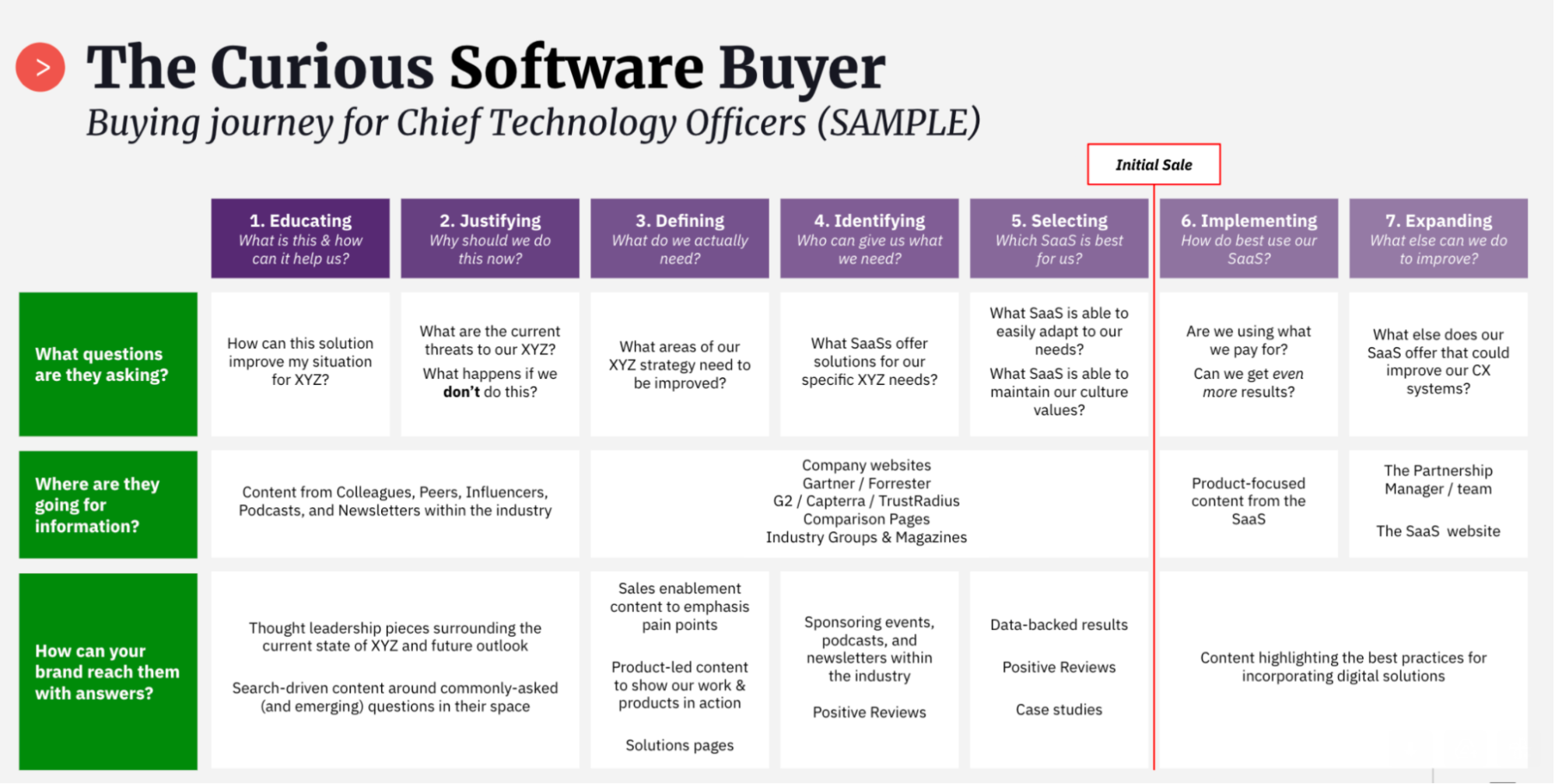

Between steps 1 – 5, notice how the CTO moves from self-educating about the problem to actively researching and comparing different solutions to find the best fit. After identifying the kind of problem they want to solve and the required solution, they start looking at who can give them what they need and the best SaaS solution for them.
That’s where Capterra comes in.
The same way Yelp is make or break for restaurants, Capterra is one of the strongest make or break platforms for B2B SaaS. They have built an SEO moat that outranks many SaaS companies for branded and comparison search terms they should be ranking for.
As a result, they generate over 80% of their traffic from organic search:
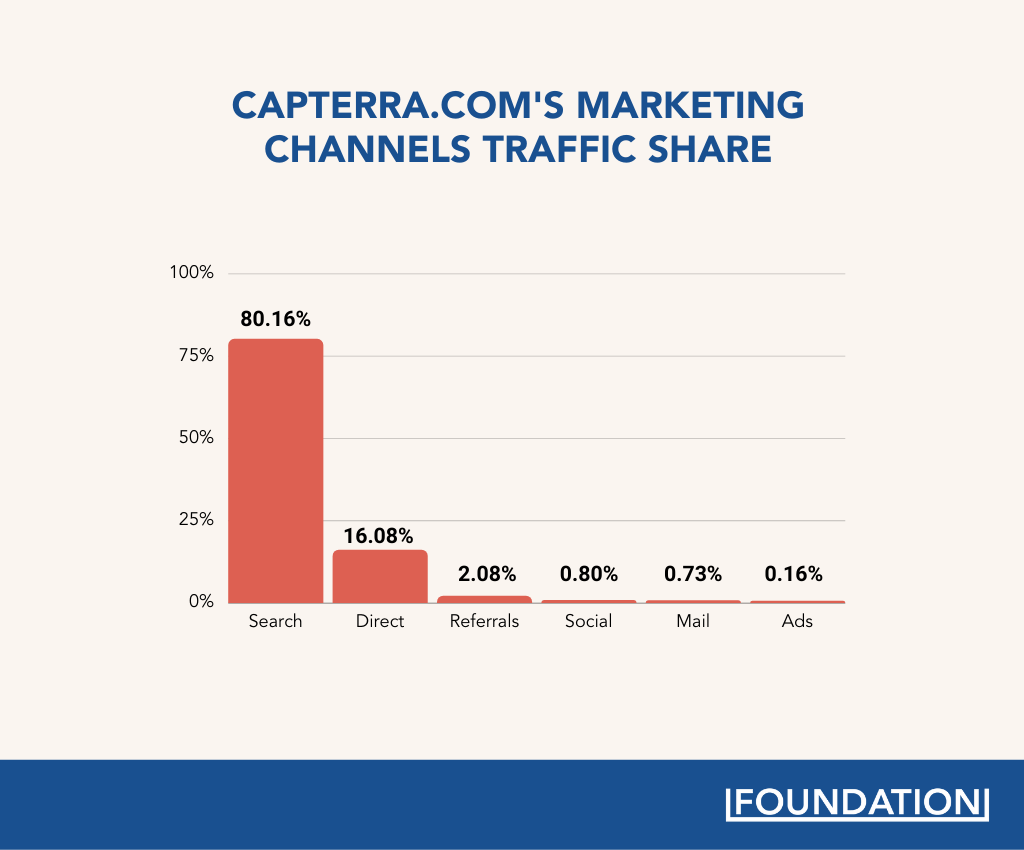

Here’s what their search scorecard looks like right now:


What attracts 1.5M people to Capterra every month via organic search isn’t just how well Capterra ranks for high-value, competitive keywords, it’s also the variety the landing pages offer as well as the quality of answers.
For example, 20,000 people search Google every month for the keyword “Inventory Management Software”. Brands like Quickbooks and its alternatives, which run ads for this phrase, spend $25 per click.
A prospect looking for “Inventory Management Software” isn’t looking to find a SaaS product landing page singing its own praises.
Instead, they want to go over different options, read each product’s description, see the features compared and associated costs, see ratings, and read user reviews. These things make the prospect more confident in their decision, and Capterra offers that:


As a result, Capterra ranks #4 on Google’s 1st SERP for the search query.


Over 5000 people visit that web page every month, and the total value of the incoming organic traffic for this page is $108,000. That’s a lot of valuable traffic for one page. Even though Zoho outranks Capterra in the SERP, it barely attracts 2K people, and its traffic value is less than $3K.
Capterra also ranks for many other high-value, competitive keywords, including these:
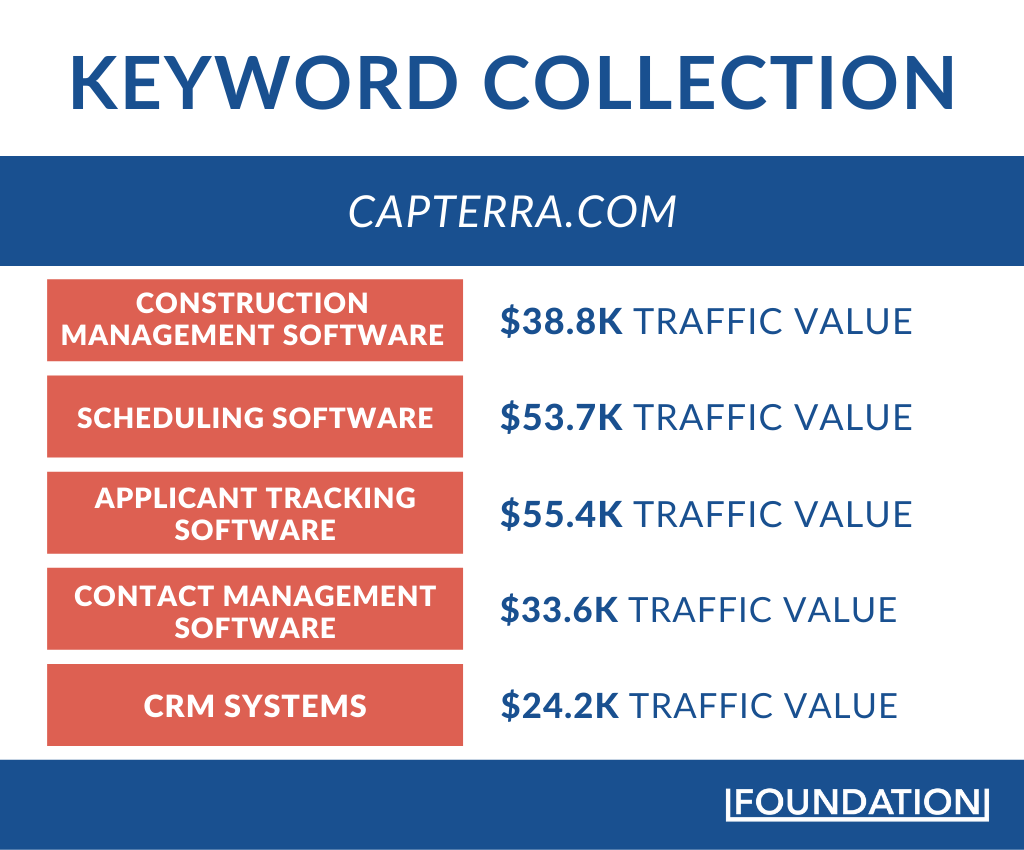

A review site like Capterra is so powerful that ignoring them or treating them as a hostile content competitor would be a huge mistake. They play a significant role in the buyer’s journey, ranking #1 for hundreds of BOFU pages.
Prospects want variety when researching solutions. They want to be able to compare solutions with all critical details of different products on a single webpage vs. jumping back and forth between tabs, trying to compare solutions on their own.
Also, Google lives for its users. They’ll naturally favor pages that best meet user needs, and Capterra has the advantage. So, trying to compete directly with Capterra with a single or a handful of product pages for the same keywords will be a lose-lose situation.
You can leverage Capterra as an ally to position your product in the best possible light for prospects already at the bottom of the funnel and gain market share. Or you can use any of the strategies below to win in the SERPs, despite Capterra’s dominance.
2 Ways SaaS Companies Can Beat Capterra in the SERPs
Make Capterra an Ally
This is an obvious yet underrated BOFU content strategy.
User reviews and ratings are effective BOFU content that acts as social proof. Although the content of these reviews is mostly beyond your direct control, they can influence your prospect’s buying decisions.
Prospects won’t want to take your word for it alone. They want to see what others are saying. That’s why 63% of consumers are more likely to purchase from a site if it has good product ratings and reviews.
Since Capterra already has the advantage with most industry keywords, leveraging their influence can help your brand. As I mentioned already, trying to beat them can result in a loss sometimes.
For example, 11,000 people search for scheduling software every month. A quick search for this keyword will reveal Capterra outranking Calendly for this keyword.
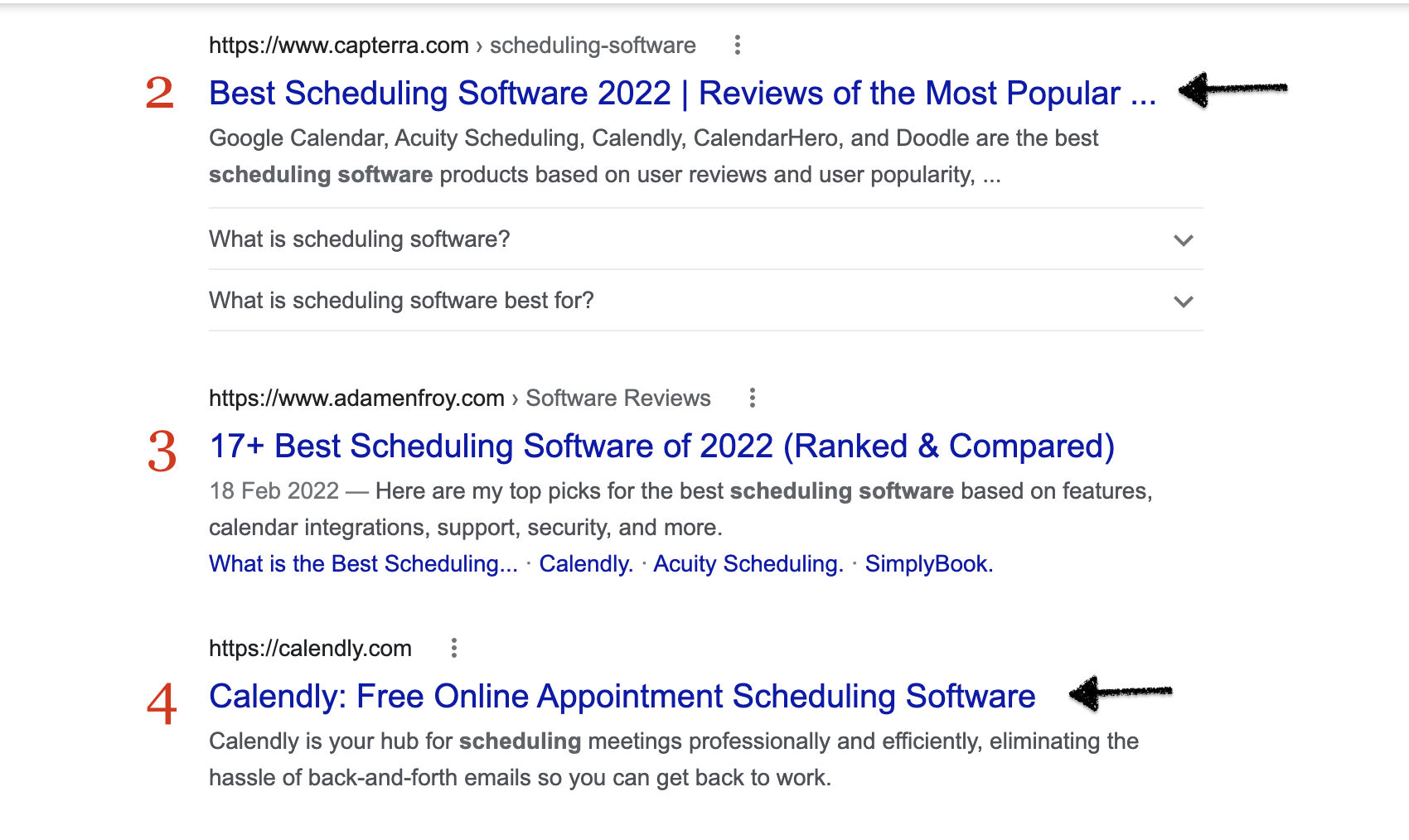

It’s great to see Calendly ranking first amidst other scheduling software.
However, a buyer who is still deciding will click to see the list of scheduling software Capterra recommends.
Capterra made the sorting process easier for prospects. Instead of looking through a list of 700+ products to determine the best fit, they created an annual shortlist filter for buyers to see a snapshot of the best-fit software.
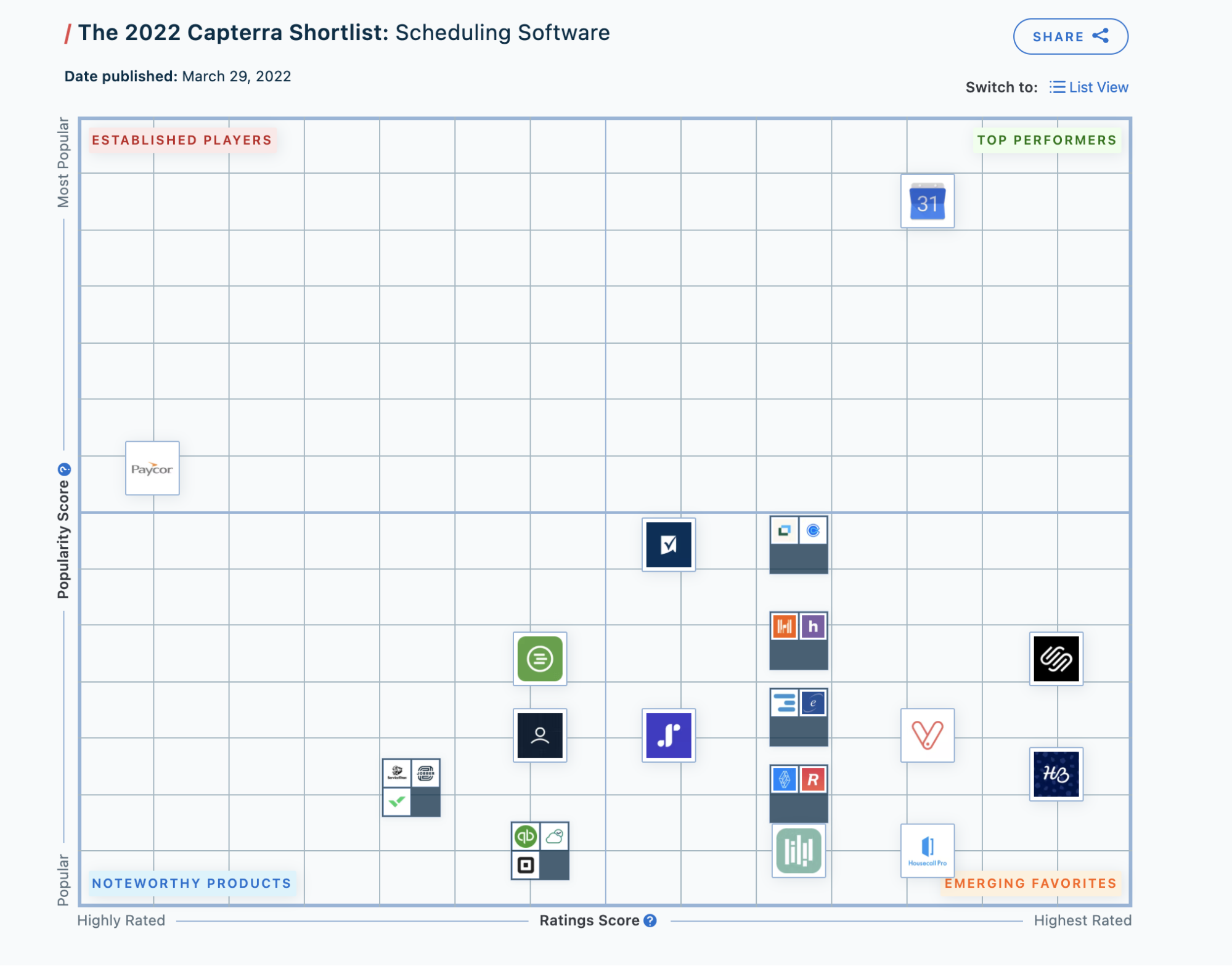

They sort these products into three categories: established players, emerging favorites, and noteworthy products. Calendly is on this list as an emerging favorite.
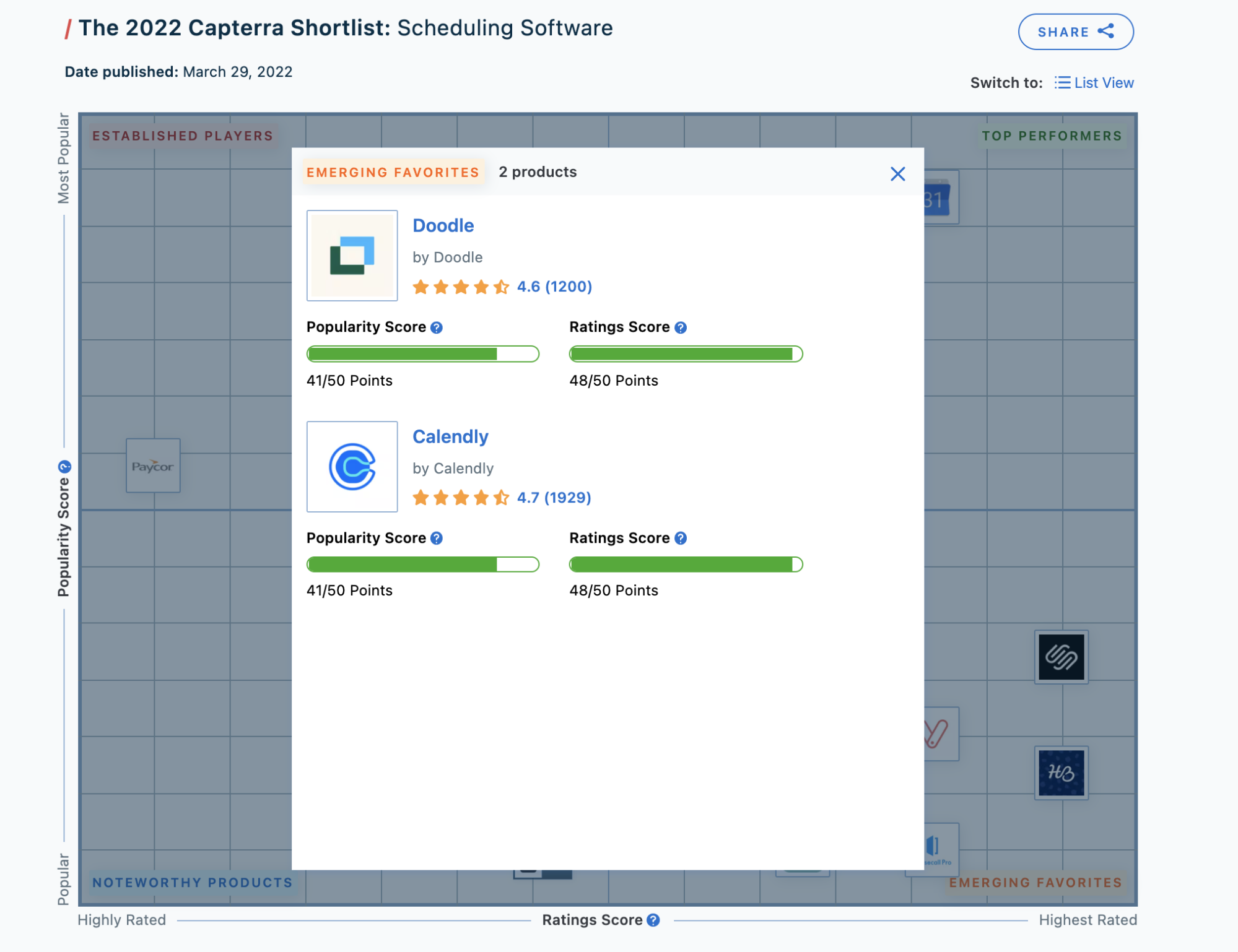

Seeing this rating, a prospect who saw Calendly on the SERP might click out of curiosity to investigate further:
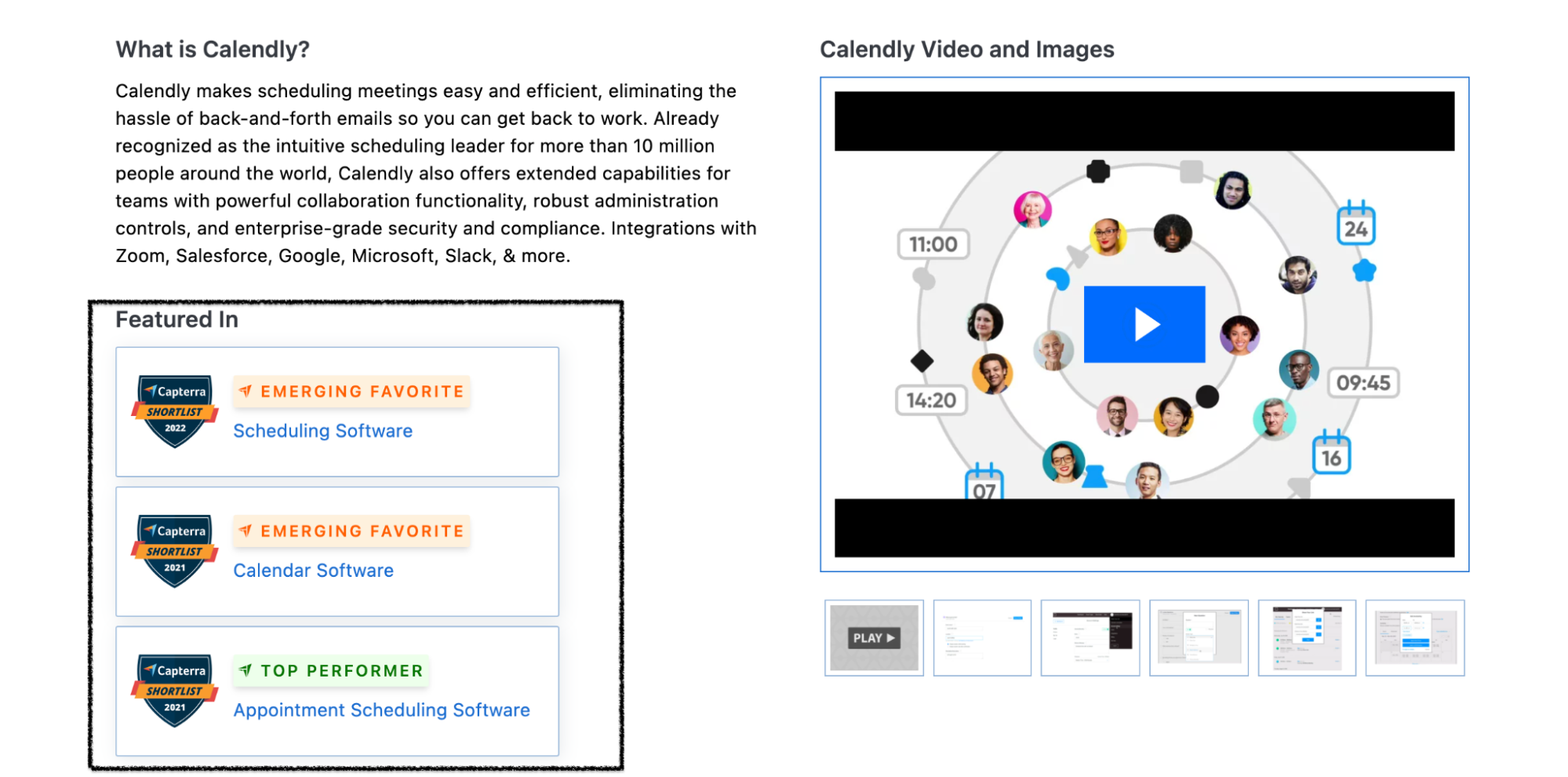

The impressive ratings and trust badges can be the social proof a prospect needs to make their final decision to choose Calendly, especially if it best meets their needs.
You can leverage third-party review sites as a part of your BOFU content mix if you’re up for it. The secret to standing out, attracting great reviews, and earning badges is to solve customer problems with a team that consistently shows up to support all the way to success.
Create Your Own Comparison Pages
If you’ve been contemplating whether or not creating comparison pages is a great investment for your brand, you can stop now.
Comparison pages are a great SaaS SEO strategy that lets you control how prospects view your product, especially in the decision stage of their journey.
Comparison pages are also important for SEO because they:
- Improve your organic search visibility and traffic.
- Help users better understand your product from the marketplace viewpoint.
- Help prospects make the best decisions with comparison content driven by in-depth keyword strategy.
With these pages, you can show your target audience how your product competes against similar products and what makes yours the best fit.
There are three ways Capterra leverages comparison pages, and you can take a page out of their playbook to craft yours:
- “Alternatives” listicles
- “Versus” articles
- “Best [industry] software” listicles
Each of these search phrases has its purpose.
For example, with the “Alternatives” listicle, you can show someone who is already actively looking for a solution the reason why they should choose your product.
The key is to study your target audience to know what their goals are. That will determine the kind of features they’ll prioritize first.
A small business owner would prioritize the cost and effectiveness of the software. A business with deeper pockets may be on the lookout for something else, such as customer support, as well as product effectiveness. It’s good to know your audience’s priorities so you can position yourself better for them.
Take this “ClickUp alternatives” search term, for instance. 900 people search to find alternatives to this software every month, and ClickUp picked up on this.
As a result, they created an alternatives listicle that attracts more search traffic than Capterra’s ClickUp Alternatives page, as well as outranks them in the SERPs:
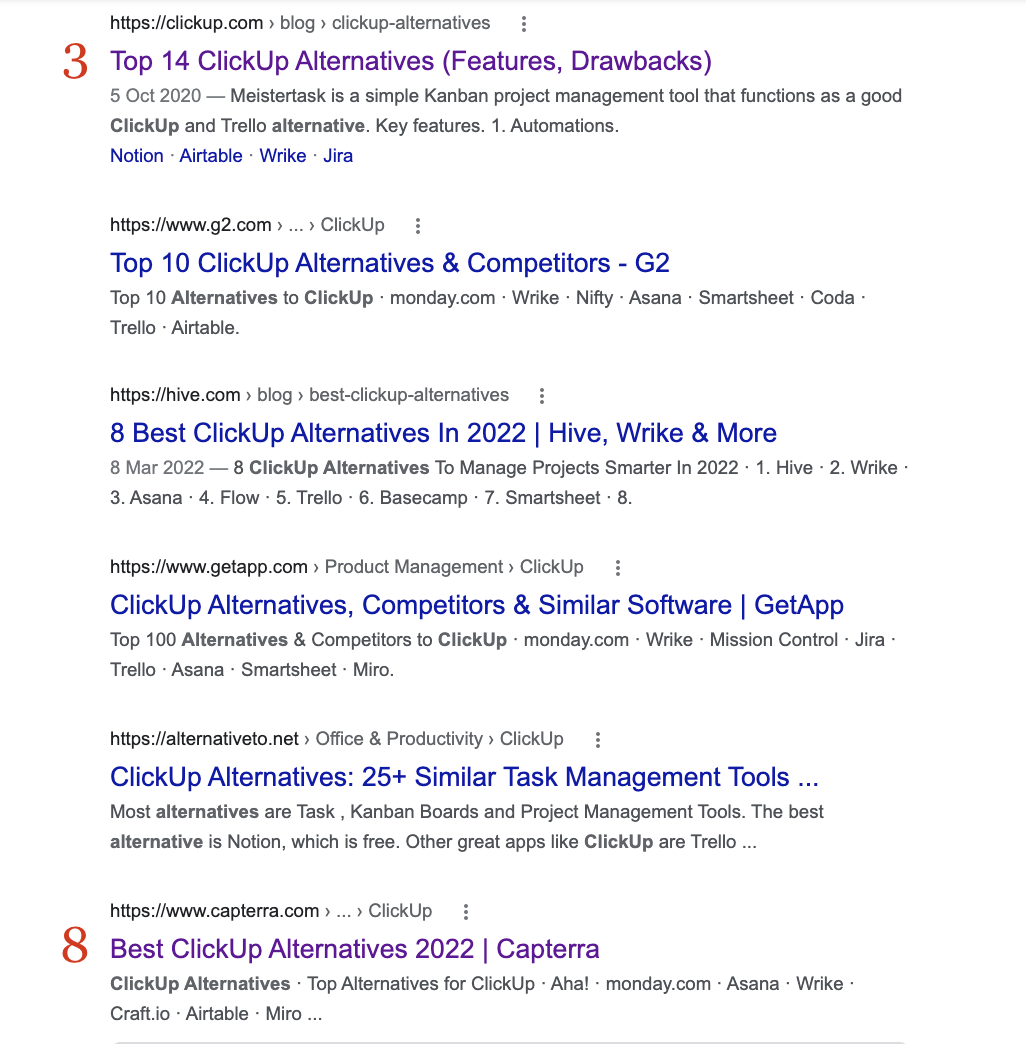

One thing ClickUp does well with this listicle is show prospects how each of these alternatives compares to them. ClickUp doesn’t trash-talk competitors. Instead, they show what makes the competition great, then they show prospects what makes their own software even better. You can see this in the inclusive language they use:
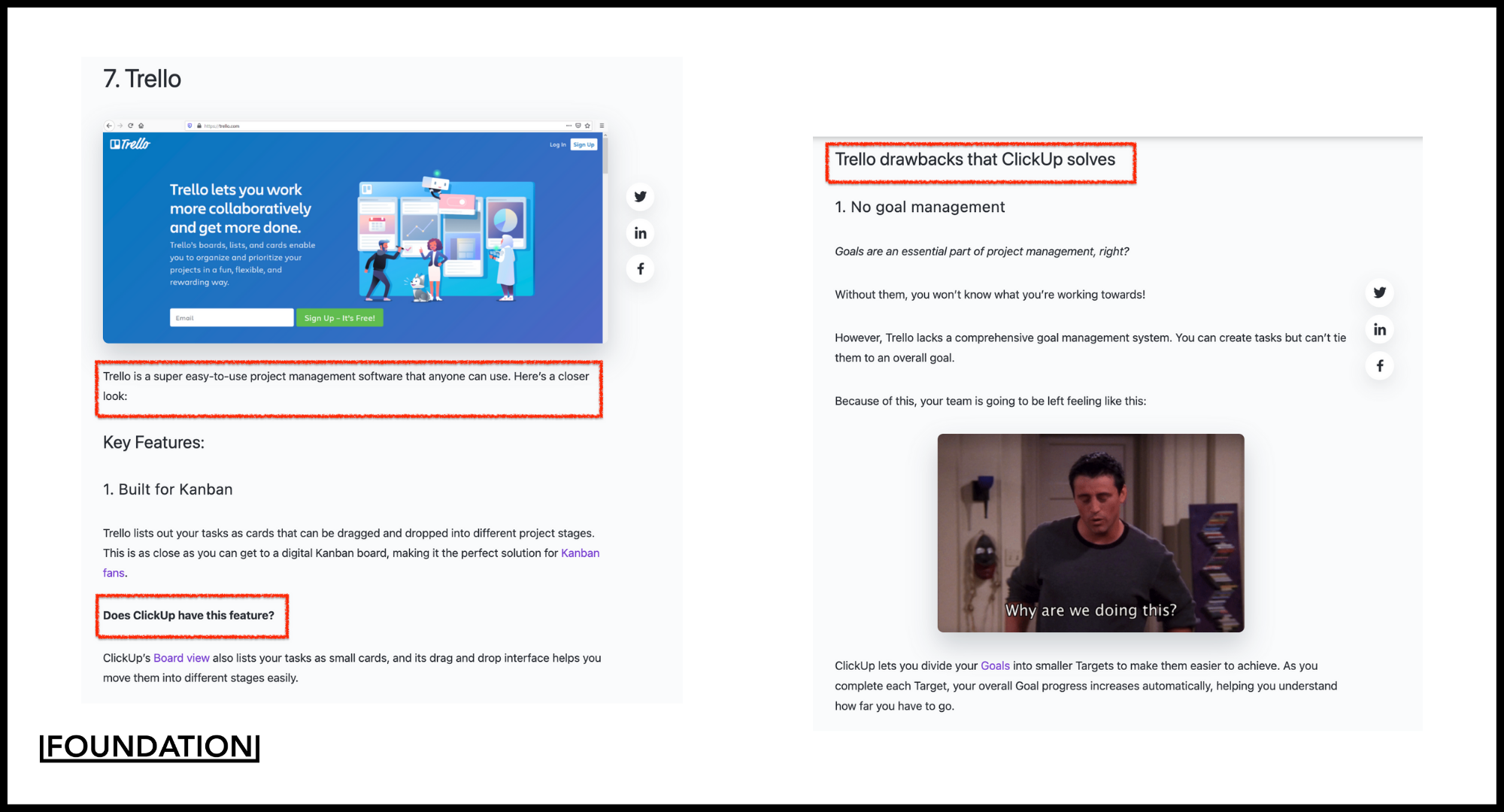

The page also ranks for all variations of the keyword:
- ClickUp alternatives – 90 monthly searches (mentioned 9 times in the article)
- ClickUp alternative – 200 monthly searches (mentioned 11 times in the article)
The page also ranks for these keywords even though they weren’t mentioned in the article:
- Alternatives to ClickUp – 100 monthly searches
- Alternative to ClickUp – 100 monthly searches
- ClickUp competitors – 30 monthly searches
Apparently, this strategy helped them beat Capterra in the SERPs and attract a good number of monthly visitors. The same strategy works for the “best [industry] software” and “versus” search queries.
The best place to begin building an “alternatives”, “versus”, or “best [industry]” page is to identify your industry keyword and seek out competitors.
Capterra has already done some of the groundwork for you. All you need to do is pop in there and check out your own profile. You’ll find a list of keywords to get your creative juices flowing.
For ClickUp, for example, you can see the keywords that define their category:
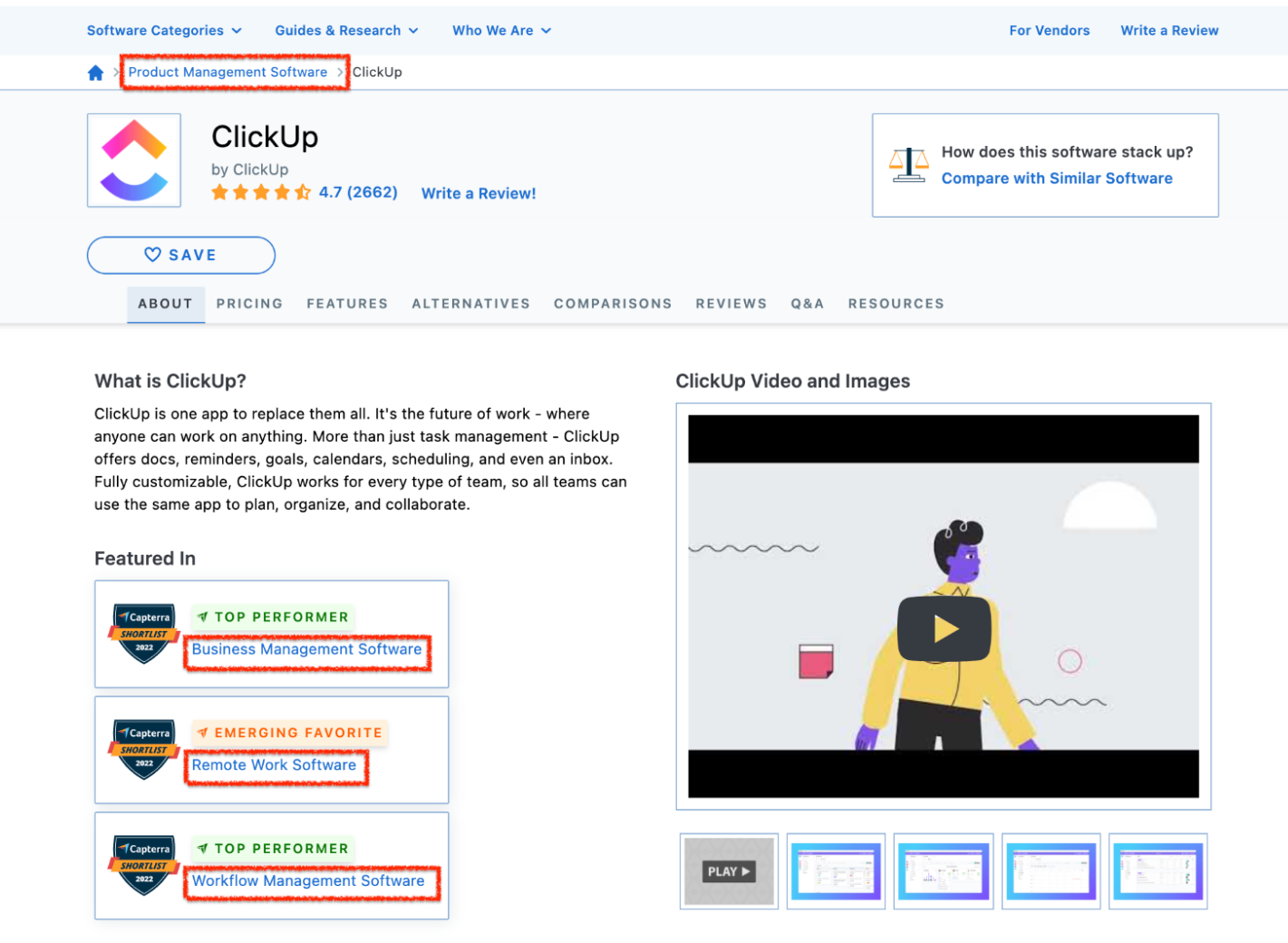

They can use these keywords as inspiration to create comparison pages that drive traction for their product, especially the low-hanging fruit. For example, “remote work software” has fewer people searching for it and way less difficulty.
If ClickUp decides to create a comparison page around this keyword, they stand a better chance at beating Capterra and driving traction for their product than they would if they go after a competitive keyword like “project management software”.
If you’re still unsure what sites you should be thinking about and looking at, here’s another pro tip Ross gave here => Type into Google “[Your Brand Name] Alternatives” or “[Your Competitor] Alternatives”. It’s likely that you will be met with everything from ads to organic listings of brands using ‘third parties’ to influence your target customers.
Wrap Up
Now you know Capterra isn’t just some content competitor. They can be a strong ally in the battle for market share. And you can also beat them in the SERPs by targeting long-tail industry keywords when creating comparison pages.
These strategies will help you show up at all the right places to capture qualified leads and turn them into happy customers. Happy customers who’ll leave smashing reviews that will bring in new customers. And the cycle keeps going.
Quick, do it now before the next drop!







